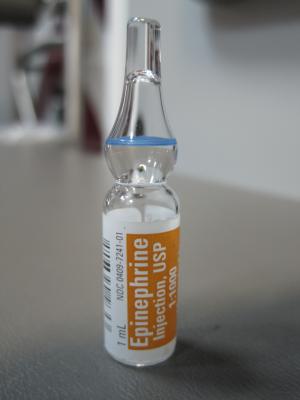
由以上的資料可以看出一點端倪:1.pH確實會影響溶液的效價;2.對於D5W及NS在大量稀釋藥品時,會連帶的增加溶液pH值,導致藥品的效價有所減少。不過可以確定的是,這類藥品由於多半為急救使用,所以也不會放太久。
所以合理的解釋為含有葡萄糖的溶液裡面葡萄糖會因為糖質分子本身的聚合作用包覆住藥品分子,讓光線及空氣不會直接作用在藥物上面而將藥物氧化,所以可以讓藥物維持效價,而NS沒有這功能。
vancomycin可以先加10mL的DSW,之後就可以用NS或是D5W稀釋了。
醫學上常用毫滲透量濃度來比較,用mOsmL-1或mOsmKg-1表示。
正常人血漿中各種離子的mOsmL-1
|
陽離子
|
mOsmL-1
|
陰離子
|
mOsmL-1
|
|
Na+
|
142
|
Cl-
|
103
|
|
K+
|
5
|
HCO3-
|
27
|
|
Ca+
|
2.5
|
HPO42-
|
1
|
|
Mg2+
|
1.5
|
SO42-
|
0.5
|
|
|
|
有機酸
|
6
|
|
|
|
蛋白質
|
2
|
|
總量
|
151.0
|
總量
|
139.5
|
|
|
Osmo (mosm)
|
Glu (g/L)
|
Na (Cl) (meq/L)
|
K (meq/L)
|
|
|
D5W
|
278
|
50
|
0
|
0
|
|
|
D10W
|
278 X2
|
50 X2
|
0
|
0
|
|
|
D50W
|
278 X10
|
50 X10
|
0
|
0
|
|
|
N/S (0.9%)
|
308
|
0
|
154
|
0
|
|
|
1/2 N/S
|
308 X1/2
|
0
|
154 X1/2
|
0
|
|
|
1/4 N/S
|
308 X1/4
|
0
|
154 X1/4
|
0
|
|
|
3% N/S
|
308 X 3
|
0
|
154 X3
|
0
|
|
|
|
Osmo (mosm)
|
Glu (g/L)
|
Na (Cl) (meq/L)
|
K (meq/L)
|
|
D5S
|
278+308=586
|
50
|
154
|
0
|
|
D5S1/2
|
278+308X1/2=432
|
50
|
154X1/2=76
|
0
|
|
D5S1/4
|
278+308X1/4=355
|
50
|
154X1/4=38
|
0
|
|
|
Osmo (mosm)
|
Glu (g/L)
|
Na (Cl) (meq/L)
|
K (meq/L)
|
HCO3- (meq/L)
|
|
L-R
|
273
|
50
|
130
|
4
|
28
|
Can J Anaesth. 2008 Mar;55(3):163-7. doi: 10.1007/BF03016090.
Stability of norepinephrine infusions prepared in dextrose and normal saline solutions.
Tremblay M, Lessard MR, Trépanier CA, Nicole PC, Nadeau L, Turcotte G.
Source
Department of Anesthesiology, Centre hospitalier affilié universitaire de Québec, Université Laval, Québec City, Québec, Canada.
Abstract
PURPOSE:
Norepinephrine (NE) infusions are commonly used in the intensive care unit and in the operating room. Data on long term stability of NE solutions are lacking. This prospective study was designed to evaluate the stability of NE, in dextrose (5%) in water (D5W) and in normal saline (NS) solutions, for a period up to seven days.
METHODS:
We prepared norepinephrine solutions in quadruplicate, by aseptically diluting 1 mg NE in 250 mL of D5W or NS and 4 mg NE in 250 mL of D5W or NS (final concentrations, 4 microg x mL(-1) and 16 micro x mL(-1), respectively) and stored the solutions at room temperature under ambient light. We sampled the solutions, in duplicate, at times 0, 24, 48, 72, 120, and 168 hr and stored them at -80 degrees C for later assay. Norepinephrine concentrations were measured by high-performance liquid chromatography with electrochemical detection (coefficient of variation 4.6%). Statistical analysis was done by nonparametric, repeated measures ANOVA (Friedman test).
RESULTS:
There was no significant decrease in NE concentration for either, NE 4 microg x mL(-1) in D5W or NS (P = 0.09 and 0.11, respectively) or for NE 16 microg x mL(-1) in D5W or NS (P = 0.18 and 0.40, respectively). The ratios of NE concentration at 168 hr, compared to baseline, were 95.7% and 96.4%, for NE 4 microg x mL(-1) in D5W and NS, respectively, and 104.5% and 96.4%, for NE 16 microg x mL(-1) in D5W and NS, respectively.
CONCLUSION:
Norepinephrine solutions, in concentrations commonly used in the clinical setting, are chemically stable for seven days, at room temperature and under ambient light, when diluted either in D5W or NS.





 留言列表
留言列表
 線上藥物查詢
線上藥物查詢 